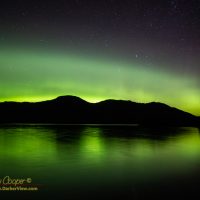When traveling in Alaska I regularly check the weather forecast. Not just the marine forecast, but the space weather forecast.

Space weather? Yes, our planet has weather out in space, weather created by streams of charged particles from our star. Sun spots, solar flares, and coronal holes can all cause these emissions to intensify. When these particles impact the magnetic field around the Earth it can create a geomagnetic storm.
The general public may not notice a geomagnetic storm, but there are those to who such storms are of great importance. If you operate communications satellites, radio communications, or long distance power transmission lines you want to know if these events are likely to occur or in progress as they can effect you operations. Thus there are space weather forecasts.
The one part of space weather that you might notice is aurora. During a geomagnetic storm auroral displays are intensified and will move further south.
This last trip we were rewarded for our vigilance. A week of clear skies and possible geomagnetic activity had us checking the skies each night. I requested that anyone up in the middle of the night take a look out the window and check.

We had moored to a small state float in Helm Bay, near Ketchikan for the night. It is a beautiful spot, the only other sign of civilization is the small forest service cabin on the shore nearby. These floats are simple, 40 feet of dock on a few pilings, no connection to shore. The State of Alaska maintains dozens of such floats across the region just for boaters and fishermen.
Question… If we spot aurora in the night, do you want to be woken up? The answer was unanimous… Yes.
It was my father who noticed an odd glow over the ridge as he was going to bed. He called me up to look. There was still a slight flush of twilight to the west, but there should be no glow to the northeast… “We have aurora!”
Wake everyone back up.
What started with a general glow over the ridge intensified into a nice display. After a while we had a nice curtain right overhead with fast moving ripples. The glow over the ridges to the north looked green to the eye, but more gold to the camera. The northern display remained for much of the night.

After a few general shots with the full sized DSLR I set up the camera with an intervalometer and started a time-lapse from the end of the float. I grabbed the little M5 to keep shooting some additional shots as the display changed overhead.
When the curtain faded overhead and my time-lapse had run long enough I put away the cameras and headed to bed. The aurora was not finished, but I was. The next day in Ketchikan I checked the space weather online. There had been a Kp=5 to 6 geomagnetic storm in the night to provide us a nice auroral display.


Wow very cool. I let it load on pause and watch. Neat jet trails also. How did u get the dock to stay still?. Nice rotation of the big dipper
Aloha
Got lucky we were even on a dock that evening, most nights we were simply at anchor. It was a state float, a dock section on pilings, but no connection to shore.